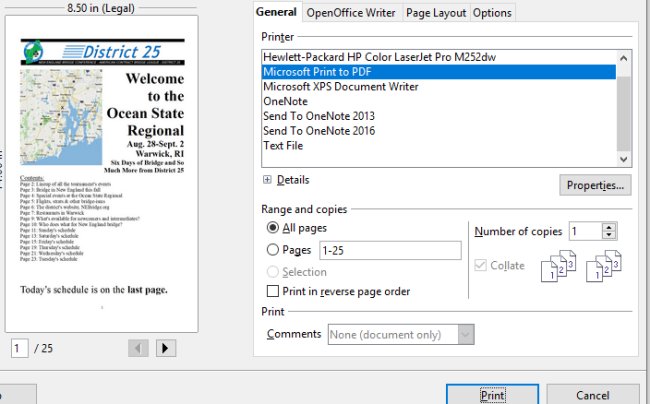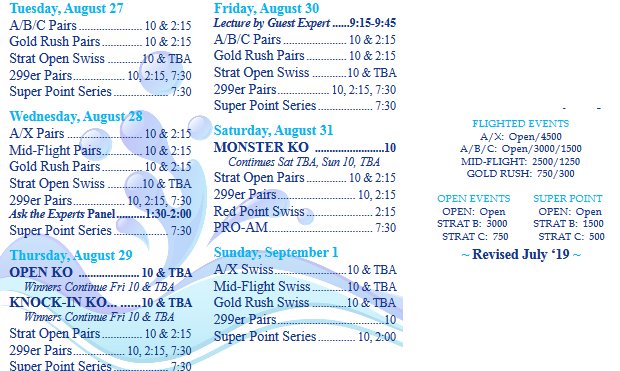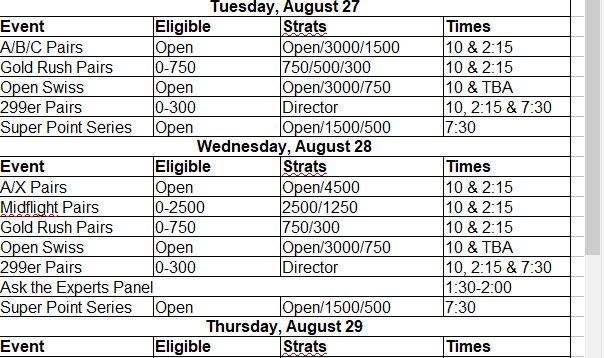

1. For each of the regional tournaments a multi-page legal-sized document is produced.
A. The bulletin editor writes or assembles the pages of the bulletin and makes a pdf file of it.

1. Windows provides the ability to create a pdf using the print function.
2. Other third party products provide this ability.
B. At least one week before the tournament the pdf file should be sent to as many people as possible for proofreading. There can never be too much proofreading.
C. The pdf file is sent to the tournament manager (tournmgr@NEBridge.org) a few days before the beginning of the tournament.
D. The Tournament Manager prints it using a black-and-white double-sided printer on colored legal-sized paper.
E. The bulletins are brought to the site by the Tournament Manager and displayed prominently on or near the Welcome Desk.
F. Early each day of the tournament (except the first) someone should remove the last page of the remaining bulletins. This ensures that the schedule for the current day is always on the last page.
2. The bulletins can be created using many different types of software. The most difficult part is fitting items together on a page in an attractive manner as rapidly as possible. So, flexibility in designing the pages is important.
3. The following layout works pretty well. The total number of pages must be an even number.
A. Page 1: Welcome message and table of contents.
B. Page 2: Schedule of events for all days.
C. Page 3: Bridge events in New England over the following few months.
D. Page 4: Special events and committee meetings at the tournament.
E. A page for newcomers outlining events in which they are likely to participate.
F. A list of restaurants in the area.
G. A list of officers in the New England Bridge Conference.
H. Pages explaining concepts of interest to New England's bridge players.
I. Two pages for each day.
1) The day-specific pages are in reverse order. The very last page contains the schedule for the first day of the tournament. It is always an even-numbered page.
2) The odd-numbered pages can contain anything of interest that will not be needed on subsequent days. Photos and write-ups of the activities from last year qualify.
4. The most important parts of the bulletin are the schedules of events. They must be consistent with one another and with the tournament flyer.

A. Create a spreadsheet of the schedule published in the flyer.
1) The columns should be event title, eligibility, strats, and times.
2) For each day:
a) One bolded row that spans all four columns with the day of the week and date.
b) One bolded row of column headings.
c) One row for each event. The titles of special events span three columns.

B. Fill in the spreadsheet. It is usually easier to copy last year's spreadsheet or one from a similar tournament.
1) The titles and times come from the schedule.
2) The eligibility is:
a) 0-299 for 299er events.
b) 0-750 for Gold Rush events.
c) 0-2500 for Mid-Flight events.
d) Open for all other events.
e) For the Senior Regional, the events that are only open to seniors must be flagged somehow.
3) The strats column:
a) Director for 299er events.
b) Bracketed for knockouts and other bracketed events.
c) Gold Rush events when there is no Mid-flight: 750/500/300. This one is not usually on the flyer.
d) Others: as specified in the strats table on the flyer.
4) The spreadsheet data can be pasted into p. 2 of the document used to create the pdf file for the online bulletin for day 1. It can either be a table or an image. This should not be done until it has been completed and checked carefully. You may have to make adjustments to make it look good on the page. The process for creating the day 1 bulletin is described here.
5) When the spreadsheet has been approved, it can be also pasted into p. 2 of the document for the printed bulletin.
6) Each day of the spreadsheet can be selected, copied, and pasted into the appropriate page of the document as a table or an image. This should not be done until it has been completed and checked carefully. You may have to make adjustments to make it look good on the page.
5. The list of restaurants, which occupies two pages, comes from the Internet -- TripAdvisor, Google, Yelp, etc. The easiest way to accumulate the necessary information is to use a spreadsheet
A. If last year's bulletin did not have a spreadsheet, create one. The columns are Category, Name, Address, Town, Phone, and Miles (from the hotel). The Town column has a one- or two-character abbreviation of towns. It can be blank for the town in which the hotel resides.
B. Sometimes you must make value judgments about how many restaurants to list and which ones. The town of Warwick has a very large number of restaurants. Lists for the other towns generally include restaurants from nearby towns.
C. The total number of restaurants that will fit in two pages is about 135.
D. Populating the two pages:
1) To copy the first page of the list of restaurants to the bulletin document, select all the columns for about half of the restaurants, copy them to the clipboard, and paste them on the first page under the Title.
2) Hide the ones that you copied but not the column headings. Select the remaining text, copy it, and past it on the second page.
3) Provide an explanation of the Town column. If possible, it should be on both pages.
4) If there is room, you can include information about where the restaurants are congregated or which address in the list are associated with malls. You might even want to include a map or two.
6. Create the other pages when you have enough information.
A. The best source for page 3 is the ACBL's calendar of tournaments. Instructions for using it are here, Select all tournaments for District 25 one month at a time.

1) To get the name of the tournament click on the appropriate "Info."
2) We also usually include District 3's tournament in Danbury, CT.
3) The dates for STaC games for Connecticut should be available on CTBridge.org.
4) Other things, such as NAP qualifying information and upcoming NABC events can also be listed.
B. The sources of information for page 4 are varied.
1) The Tournament Manager provides hospitality and room information.
2) The Vice-president provides the names of the expert panelists and the lecturer.
3) The Secretary provides the information about committee meetings.
C. The remaining pages should contain useful or interesting information. It is OK to reuse pages from previous bulletins, but the text often needs to be updated.
